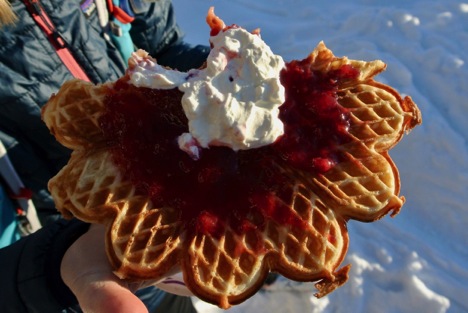Late last April, a few weeks into our period of pandemic-induced self-isolation, I was struck hard by a moment of déjà vu. My wife, Rachel, and I were on a forested dirt road about a dozen miles from home, pulled over in the middle of a bike ride to snack on heart-shaped waffles slathered in peanut butter. Two years earlier, we could have been found doing the same exact thing near Oslo, Norway, coming to the end of a year spent living abroad. And the parallels between that day and how we were coping with the pandemic and how we lived our days in Scandinavia had become striking.

During that year abroad, I lived a pretty quiet existence while Rachel traveled from Sjusjøen to Trondheim to Kirkenes, teaching about American civics and education at lower secondary schools while on a Fulbright Fellowship. While she was gone for weeks at a time, I’d begin almost every morning by stretching in our excessively tidy 20-square-meter apartment. Then I’d head into the Nordmarka, the northern forest just beyond the city that’s webbed with trails that I skate skied by winter, pedaled by summer and ran in the time between. Then I’d work for the middle of the day at the kitchen table—or occasionally a crowded café or tall-ceilinged library—before video chatting with someone at home many evenings. Following dinner, I’d walk through the neighborhood before reading by candlelight…because Norwegians love their candles.
Over those 11 months, obligations felt minimal, friends were an ocean away, and my life took on a calm, almost monastic quality. And while my routines during COVID-19 seemed to return to those I practiced in Norway—walking, stretching, working from the kitchen, connecting with friends by screen—I’ve seen many others adopt similar behaviors.
My flashback on that April bike ride was spurred by the staggering number of people doing yard work who paused when we passed by, looked up and waved hello. And the number of cars that patiently and surprisingly offered us the right of way. And the number of twosomes enjoying a walk on the forest-lined dirt roads we were riding. While headlines from the cities shouted with anxiety and fear, the world around our rural Vermont home seemed to be developing some sort of incongruous calm. People were slowing down, embracing their surroundings and finding contentment in small, quiet acts.
A couple years ago, Americans became fascinated by the Danish concept of hygge. The Norwegian equivalent is koselig and captures the feeling of coziness and comfort typically sought during the darkness and cold of winter by surrounding oneself in warmth, ample candlelight and layer upon layer—scarves upon sweaters upon blankets—of wool. More recently, another concept has drifted west from the Arctic Ocean, that of friluftsliv, a style of outdoor living that transcends sport and recreation, rain and cold. Norwegians’ lives revolve around being outside, whether in friluftsbarnehage (outdoor kindergarten, which is basically the norm) or on the public trails and paths that wind through every city and village.
Thanks probably to Pinterest, American consumerism and an infatuation with most things Scandinavian, hygge caught on pretty quickly in the U.S. But until COVID-19 pushed all safe forms of gathering, dining and recreation outside, friluftsliv has remained more ethereal. Together, these concepts are a powerful antidote to the social and psychological side effects of the pandemic. While many people began to embrace the practices I’d associate with hygge, koselig and friluftsliv late last winter and since then, I expect they’ll only become more prevalent during what some have called the darkest winter of our lives.
I’d bet my wind briefs that another Norwegian tradition will become increasingly popular along with cozy blankets and candles and outdoor: cross country skiing. It’s the most accessible, affordable and family-oriented way to ski. It’s just as fulfilling whether practiced socially or alone, at a cross country center or out the back door, in slush or a squall, at night or during the day. It’s how the Norwegians enjoy friluftsliv—their open air living—during winter.
When this winter is through, I hope these Scandinavian practices brought on by the pandemic become more than passing fads in America. I hope they become part of our lifestyle.
—
This essay was originally published in the early winter 2021 issue of Cross Country Skier Magazine (#40.2).